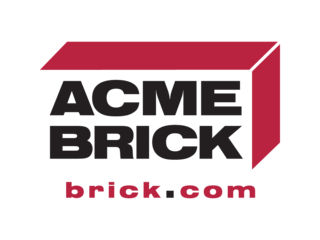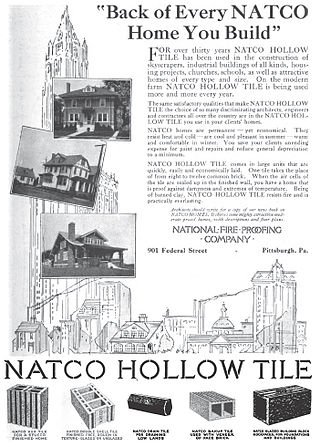
A brick is a type of construction material used to build walls, pavements and other elements in masonry construction. Properly, the term brick denotes a unit primarily composed of clay, but is now also used informally to denote units made of other materials or other chemically cured construction blocks. Bricks can be joined using mortar, adhesives or by interlocking. Bricks are usually produced at brickworks in numerous classes, types, materials, and sizes which vary with region, and are produced in bulk quantities.

Delftware or Delft pottery, also known as Delft Blue or as delf, is a general term now used for Dutch tin-glazed earthenware, a form of faience. Most of it is blue and white pottery, and the city of Delft in the Netherlands was the major centre of production, but the term covers wares with other colours, and made elsewhere. It is also used for similar pottery, English delftware.

Elgin is a city in Bastrop County in the U.S. state of Texas. The population was 9,784 at the 2020 census. Elgin is also known as the Sausage Capital of Texas and the Brick Capital of the Southwest, due to the presence of three operating brickyards in the mid-20th century.

Terracotta, also known as terra cotta or terra-cotta, is a term used in some contexts for earthenware. It is a clay-based non-vitreous ceramic, fired at relatively low temperatures.

Alfred Waterhouse was an English architect, particularly associated with the Victorian Gothic Revival architecture, although he designed using other architectural styles as well. He is perhaps best known for his designs for Manchester Town Hall and the Natural History Museum in London, although he also built a wide variety of other buildings throughout the country. Besides his most famous public buildings he designed other town halls, the Manchester Assize buildings—bombed in World War II—and the adjacent Strangeways Prison. He also designed several hospitals, the most architecturally interesting being the Royal Infirmary Liverpool and University College Hospital London. He was particularly active in designing buildings for universities, including both Oxford and Cambridge but also what became Liverpool, Manchester and Leeds universities. He designed many country houses, the most important being Eaton Hall in Cheshire, largely demolished in 1961-63. He designed several bank buildings and offices for insurance companies, most notably the Prudential Assurance Company. Although not a major church designer he produced several notable churches and chapels. He was both a member of The Royal Institute of British Architects, of which he served a term as President, and a Royal Academician, acting as Treasurer for the Royal Academy.

Tiles are usually thin, square or rectangular coverings manufactured from hard-wearing material such as ceramic, stone, metal, baked clay, or even glass. They are generally fixed in place in an array to cover roofs, floors, walls, edges, or other objects such as tabletops. Alternatively, tile can sometimes refer to similar units made from lightweight materials such as perlite, wood, and mineral wool, typically used for wall and ceiling applications. In another sense, a tile is a construction tile or similar object, such as rectangular counters used in playing games. The word is derived from the French word tuile, which is, in turn, from the Latin word tegula, meaning a roof tile composed of fired clay.

A fire brick, firebrick, fireclay brick, or refractory brick is a block of ceramic material used in lining furnaces, kilns, fireboxes, and fireplaces. A refractory brick is built primarily to withstand high temperature, but will also usually have a low thermal conductivity for greater energy efficiency. Usually dense fire bricks are used in applications with extreme mechanical, chemical, or thermal stresses, such as the inside of a wood-fired kiln or a furnace, which is subject to abrasion from wood, fluxing from ash or slag, and high temperatures. In other, less harsh situations, such as in an electric or natural gas fired kiln, more porous bricks, commonly known as "kiln bricks", are a better choice. They are weaker, but they are much lighter and easier to form and insulate far better than dense bricks. In any case, firebricks should not spall, and their strength should hold up well during rapid temperature changes.

The American Terracotta Tile and Ceramic Company was founded in 1881; originally as Spring Valley Tile Works; in Terra Cotta, Illinois, between Crystal Lake, Illinois and McHenry, Illinois near Chicago by William Day Gates. It became the country's first manufactury of architectural terracotta in 1889. The production consisted of drain tile, brick, chimney tops, finials, urns, and other economically fireproof building materials. Gates used the facilities to experiment with clays and glazes in an effort to design a line of art pottery which led to the introduction of Teco Pottery. American Terra Cotta's records are housed at the University of Minnesota and include original architectural drawings.

Architectural terracotta refers to a fired mixture of clay and water that can be used in a non-structural, semi-structural, or structural capacity on the exterior or interior of a building. Terracotta pottery, as earthenware is called when not used for vessels, is an ancient building material that translates from Latin as "baked earth". Some architectural terracotta is actually stronger than stoneware. It can be unglazed, painted, slip glazed, or glazed. A piece of terracotta is composed of a hollow clay web enclosing a void space or cell. The cell can be installed in compression with mortar or hung with metal anchors; such cells are often partially backfilled with mortar.

Ceramic glaze, or simply glaze, is a glassy coating on ceramics. It is used for decoration, to ensure the item is impermeable to liquids and to minimise the adherence of pollutants.

Acme Brick Company is an American manufacturer and distributor of brick and masonry-related construction products and materials. Founder George E. Bennett, chartered the company as the Acme Pressed Brick Company on April 17, 1891, in Alton, Illinois, although the company's physical location has always been in Texas. The company grew to become the largest American-owned brick manufacturer by the mid-20th century and was the first of its type to offer a 100-year limited guarantee to its customers. Acme Brick Company was acquired by Berkshire Hathaway on August 1, 2000.

CoorsTek, Inc. is a privately owned manufacturer of technical ceramics for aerospace, automotive, chemical, electronics, medical, metallurgical, oil and gas, semiconductor and many other industries. CoorsTek headquarters and primary factories are located in Golden, Colorado, US. The company is wholly owned by Keystone Holdings LLC, a trust of the Coors family. John K. Coors, a great-grandson of founder and brewing magnate Adolph Coors Sr., and the fifth and youngest son of longtime chairman and president Joseph Coors, retired as president and chairman in January 2020 after 22 years at the helm.

Roof tiles are overlapping tiles designed mainly to keep out rain or snow, and are traditionally made from locally available materials such as clay or slate. Later tiles have been made from materials such as concrete, and plastic.

Gladding, McBean is a ceramics company located in Lincoln, California. It is one of the oldest companies in California, a pioneer in ceramics technology, and a company which has "contributed immeasurably" to the state's industrialization. During the heyday of architectural terra cotta, the company "dominated the industry in California and the Far West."

Franciscan Ceramics are ceramic tableware and tile products produced by Gladding, McBean & Co. in Los Angeles, California, US from 1934 to 1962, International Pipe and Ceramics (Interpace) from 1962 to 1979, and Wedgwood from 1979 to 1983. Wedgwood closed the Los Angeles plant, and moved the production of dinnerware to England in 1983. Waterford Glass Group plc purchased Wedgwood in 1986, becoming Waterford Wedgwood. KPS Capital Partners acquired all of the holdings of Waterford Wedgwood in 2009. The Franciscan brand became part of a group of companies known as WWRD, an acronym for "Wedgwood Waterford Royal Doulton." WWRD continues to produce the Franciscan patterns Desert Rose and Apple.

Structural clay tile describes a category of burned-clay building materials used to construct roofing, walls, and flooring for structural and non-structural purposes, especially in fireproofing applications. Also called building tile, structural terra cotta, hollow tile, saltillo tile, and clay block, the material is an extruded clay shape with substantial depth that allows it to be laid in the same manner as other clay or concrete masonry. In North America it was chiefly used during the late 19th and early 20th centuries, reaching peak popularity at the turn of the century and declining around the 1950s. Structural clay tile grew in popularity in the end of the nineteenth-century because it could be constructed faster, was lighter, and required simpler flat falsework than earlier brick vaulting construction. Each unit is generally made of clay or terra-cotta with hollow cavities, or cells, inside it. The colors of terracotta transform from gray to orange, red, yellow, and cream tones. This is due to an effect of the firing process which hardens the clay so it can be used for structural purposes. The material is commonly used in floor arches, fireproofing, partition walls, and furring. It continues to be used in Europe to build fire-resistant walls and partitions. In North America the material has largely been replaced by concrete masonry units.
Fireclay Tile is a North American architectural tile company. Founded in 1986 by Paul Burns, Jeff Alvord, Martin Zepeda, and Albert Batista. Fireclay is known for designing and hand-making tile in Northern California, while actively incorporating environmentally sustainable practices.

Ceramic art is art made from ceramic materials, including clay. It may take varied forms, including artistic pottery, including tableware, tiles, figurines and other sculpture. As one of the plastic arts, ceramic art is a visual art. While some ceramics are considered fine art, such as pottery or sculpture, most are considered to be decorative, industrial or applied art objects. Ceramic art can be created by one person or by a group, in a pottery or a ceramic factory with a group designing and manufacturing the artware.
Butler is an unincorporated community in Bastrop County, Texas, United States. It is located within the Greater Austin metropolitan area.
Rufus Bradley Keeler was a master ceramicist and ceramics glaze expert. He was plant superintendent of California China Products, a co-founder of California Clay Products (CalCo), and plant manager of Malibu Potteries. He was married to Mary E. Leary and had three sons and one daughter, including ceramicist Bradley Burr Keeler, who founded Brad Keeler Artwares and who came to be president of the California Art Potters Association and director of the California Gift and Art Association.

















